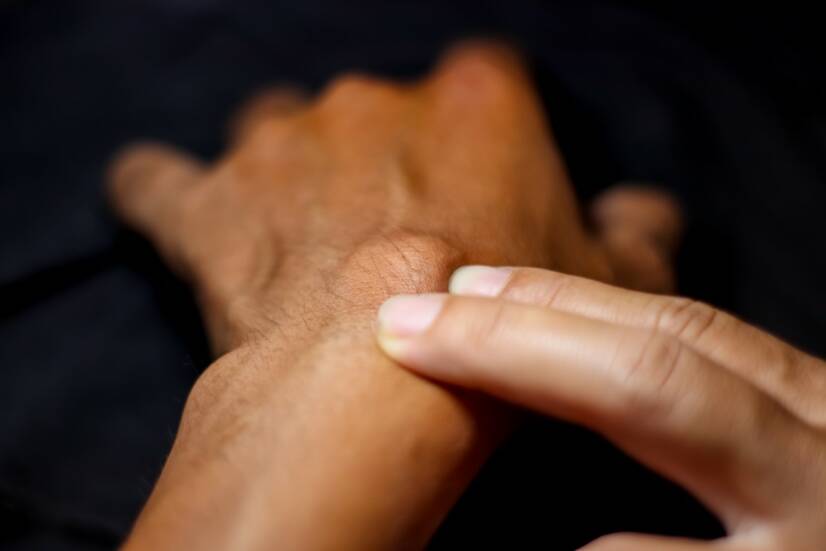- medicalnewstoday.com - Ganglion cysts and their removal
- mayoclinic.org - Ganglion cyst
- pubmed.ncbi.nlm.nih.gov - Ganglion cyst
- ncbi.nlm.nih.gov - Ganglion cyst
What is ganglion and why does it occur? What are the symptoms?

Ganglion cysts are benign cysts that are filled with a gelatinous mass. They are a very common orthopaedic diagnosis. The cause of these cysts is not precisely known. It is thought that they arise from repetitive microtrauma in the joint area. Non-operative and surgical approaches are used in therapy. The location of the ganglion, the adjacent anatomical structures and the degree of discomfort it causes are decisive.
Characteristics
Ganglions are synovial cysts.
Synovial fluid is a gel-like liquid mass that is naturally found in the joint crevice. Synovium is a joint lubricant that reduces friction on the joint surfaces and performs a nourishing function.
The main components of synovial fluid are hyaluronic acid and chondroitin sulfate.
Ganglions are a very common diagnosis in orthopaedic outpatient clinics. They account for approximately 60% to 70% of soft tissue 'bulges' of the hand and wrist with which patients see specialists.
They occur at any age in both sexes, but women between the ages of 20 and 50 are most often affected. Women are up to three times more likely to develop ganglia than men.
Typically, professional gymnasts are affected, precisely because of frequent overtraining and numerous microtraumas in the wrist joint area.
Ganglion cysts have a characteristic location. Up to 70% of ganglion cysts are found on the back of the wrist. Another 20% of ganglion cysts are located on the inside of the wrist under the palm.
The remaining 10% or so can be anywhere on the body, for example on the foot or ankle. These cysts are very common in women who suffer from osteoarthritis.
Causes
A second, more modern theory was presented by the scientists Carp and Stout in 1926, based on the belief that ganglion cysts arise as a result of mucinous degeneration of the connective tissue caused by repeated chronic damage to the joint area.
Current knowledge suggests that ganglion cysts arise from so-called mesenchymal cells. These are stem cells that can differentiate (change/maturate) into bone, fat, cartilage, nerve, muscle or heart cells.
These cells are also found in the joint, specifically in the synovial membrane that lines the joint capsule and produces synovial fluid.
Overuse of particularly small joints and microtrauma to these areas is a risk factor for the development of these nodules.
Minor but repeated injuries to joint structures stimulate cells to produce hyaluronic acid, the main component of synovial fluid, which accumulates and forms cysts.
Symptoms
Ganglions are firm, hard, well-circumscribed, round nodules. They may be 1-3 cm in diameter but sometimes reach the size of a golf ball.
They are often fixed to deep tissues rather than overlying skin, so that the skin over them can be mobile. They may also have a variable length of pedicel that allows them to move freely.
If a ganglion is located where a nerve fibre or blood vessel passes through, it may present with the following symptoms, which are exacerbated by movement in a joint, such as the wrist:
- Pain
- tenderness
- weakness
- burning or tingling
If the nodule is located in the wrist, patients may develop so-called carpal tunnel syndrome.
If the nodule forms near a blood vessel, the pressure of the cyst can cause the blood vessel to become oppressed, resulting in ischemia or anemia of the tissue that the blood vessel nourishes.
Diagnostics
A simple and quick examination is to shine a strong light source, usually a small flashlight, through the nodule.
Imaging is used in diagnosis to distinguish it from other benign lumps, such as lipoma, which is a benign tumour made of fat cells.
X-ray examination is beneficial to rule out other process in the bones and joints. If a malignant tumor is suspected, the lump may be examined by magnetic resonance imaging (MRI).
MRI will show a well-defined round soft tissue mass containing fluid.
Ultrasonography (USG) is used to examine the vascular system around the ganglion or to differentiate a ganglion from a vascular malformation.
Course
If it is small, it may not cause any symptoms. However, if it grows to a larger size, it can press on nerves and blood vessels in its surroundings and cause pain or sensory disturbances. There may be reduced sensitivity or, conversely, tingling and burning, for example of the fingers of the hand.
In most cases of asymptomatic cysts, observation is sufficient. Some may even heal spontaneously and disappear.
If the ganglion starts to cause unpleasant symptoms or becomes too large and unsightly, invasive treatment is resorted to. Treatment involves aspiration, i.e. removal of the cyst, or surgical removal of the nodule.
How it is treated: Ganglion
Treatment of ganglia: is it conservative or only surgical?
Show moreGanglion is treated by
Other names
Interesting resources
Related










